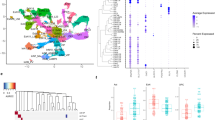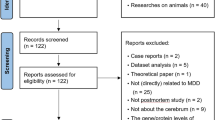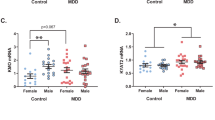Abstract
Accumulating data indicate that the glutamate system is disrupted in major depressive disorder (MDD), and recent clinical research suggests that ketamine, an antagonist of the N-methyl-d-aspartate (NMDA) glutamate receptor (GluR), has rapid antidepressant efficacy. Here we report findings from gene expression studies of a large cohort of postmortem subjects, including subjects with MDD and controls. Our data reveal higher expression levels of the majority of glutamatergic genes tested in the dorsolateral prefrontal cortex (DLPFC) in MDD (F21,59=2.32, P=0.006). Posthoc data indicate that these gene expression differences occurred mostly in the female subjects. Higher expression levels of GRIN1, GRIN2A-D, GRIA2-4, GRIK1-2, GRM1, GRM4, GRM5 and GRM7 were detected in the female patients with MDD. In contrast, GRM5 expression was lower in male MDD patients relative to male controls. When MDD suicides were compared with MDD non-suicides, GRIN2B, GRIK3 and GRM2 were expressed at higher levels in the suicides. Higher expression levels were detected for several additional genes, but these were not statistically significant after correction for multiple comparisons. In summary, our analyses indicate a generalized disruption of the regulation of the GluRs in the DLPFC of females with MDD, with more specific GluR alterations in the suicides and in the male groups. These data reveal further evidence that, in addition to the NMDA receptor, the AMPA, kainate and the metabotropic GluRs may be targets for the development of rapidly acting antidepressant drugs.
This is a preview of subscription content, access via your institution
Access options
Subscribe to this journal
Receive 12 print issues and online access
$259.00 per year
only $21.58 per issue
Buy this article
- Purchase on Springer Link
- Instant access to full article PDF
Prices may be subject to local taxes which are calculated during checkout



Similar content being viewed by others
References
Conwell Y, Brent D . Suicide and aging. I: Patterns of psychiatric diagnosis. Int Psychogeriatr 1995; 7: 149–164.
Trivedi MH, Rush AJ, Wisniewski SR, Nierenberg AA, Warden D, Ritz L et al. Evaluation of outcomes with citalopram for depression using measurement-based care in STAR*D: implications for clinical practice. Am J Psychiatry 2006; 163: 28–40.
Sanacora G, Treccani G, Popoli M . Towards a glutamate hypothesis of depression: an emerging frontier of neuropsychopharmacology for mood disorders. Neuropharmacology 2012; 62: 63–77.
Lodge D . The history of the pharmacology and cloning of ionotropic glutamate receptors and the development of idiosyncratic nomenclature. Neuropharmacology 2009; 56: 6–21.
Berman RM, Cappiello A, Anand A, Oren DA, Heninger GR, Charney DS et al. Antidepressant effects of ketamine in depressed patients. Biol Psychiatry 2000; 47: 351–354.
Kudoh M, Sakai M, Shibuki K . Differential dependence of LTD on glutamate receptors in the auditory cortical synapses of cortical and thalamic inputs. J Neurophysiology 2002; 88: 3167–3174.
Zarate CA Jr., Singh J, Manji HK . Cellular plasticity cascades: targets for the development of novel therapeutics for bipolar disorder. Biol Psychiatry 2006; 59: 1006–1020.
Duman RS, Voleti B . Signaling pathways underlying the pathophysiology and treatment of depression: novel mechanisms for rapid-acting agents. Trends Neurosci 2012; 35: 47–56.
Covvey JR, Crawford AN, Lowe DK . Intravenous ketamine for treatment-resistant major depressive disorder. Ann Pharmacother 2012; 46: 117–123.
Maeng S, Zarate CA Jr . The role of glutamate in mood disorders: results from the ketamine in major depression study and the presumed cellular mechanism underlying its antidepressant effects. Curr Psychiatry Rep 2007; 9: 467–474.
Stryjer R, Strous RD, Shaked G, Bar F, Feldman B, Kotler M et al. Amantadine as augmentation therapy in the management of treatment-resistant depression. Int Clin Psychopharmacol 2003; 18: 93–96.
Coric V, Milanovic S, Wasylink S, Patel P, Malison R, Krystal JH . Beneficial effects of the antiglutamatergic agent riluzole in a patient diagnosed with obsessive-compulsive disorder and major depressive disorder. Psychopharmacology (Berl) 2003; 167: 219–220.
Zarate CA Jr., Payne JL, Quiroz J, Sporn J, Denicoff KK, Luckenbaugh D et al. An open-label trial of riluzole in patients with treatment-resistant major depression. Am J Psychiatry 2004; 161: 171–174.
Sanacora G, Kendell SF, Levin Y, Simen AA, Fenton LR, Coric V et al. Preliminary evidence of riluzole efficacy in antidepressant-treated patients with residual depressive symptoms. Biol Psychiatry 2007; 61: 822–825.
Heller AS, Johnstone T, Peterson MJ, Kolden GG, Kalin NH, Davidson RJ . Increased prefrontal cortex activity during negative emotion regulation as a predictor of depression symptom severity trajectory over 6 months. JAMA Psychiatry 2013; 70: 1181–1189.
Kang HJ, Voleti B, Hajszan T, Rajkowska G, Stockmeier CA, Licznerski P et al. Decreased expression of synapse-related genes and loss of synapses in major depressive disorder. Nat Med 2012; 18: 1413–1417.
Lee PH, Perlis RH, Jung JY, Byrne EM, Rueckert E, Siburian R et al. Multi-locus genome-wide association analysis supports the role of glutamatergic synaptic transmission in the etiology of major depressive disorder. Transl Psychiatry 2012; 2: e184.
Minelli A, Scassellati C, Bonvicini C, Perez J, Gennarelli M . An association of GRIK3 Ser310Ala functional polymorphism with personality traits. Neuropsychobiology 2009; 59: 28–33.
Paddock S, Laje G, Charney D, Rush AJ, Wilson AF, Sorant AJ et al. Association of GRIK4 with outcome of antidepressant treatment in the STAR*D cohort. Am J Psychiatry 2007; 164: 1181–1188.
Schiffer HH, Heinemann SF . Association of the human kainate receptor GluR7 gene (GRIK3) with recurrent major depressive disorder. Am J Med Genet B Neuropsychiatr Genet 2007; 144B: 20–26.
Chiesa A, Crisafulli C, Porcelli S, Han C, Patkar AA, Lee SJ et al. Influence of GRIA1, GRIA2 and GRIA4 polymorphisms on diagnosis and response to treatment in patients with major depressive disorder. Eur Arch Psychiatry Clin Neurosci 2012; 262: 305–311.
Tsunoka T, Kishi T, Ikeda M, Kitajima T, Yamanouchi Y, Kinoshita Y et al. Association analysis of group II metabotropic glutamate receptor genes (GRM2 and GRM3) with mood disorders and fluvoxamine response in a Japanese population. Prog Neuropsychopharmacol Biol Psychiatry 2009; 33: 875–879.
Fish EW, Shahrokh D, Bagot R, Caldji C, Bredy T, Szyf M et al. Epigenetic programming of stress responses through variations in maternal care. Ann NY Acad Sci 2004; 1036: 167–180.
Feyissa AM, Woolverton WL, Miguel-Hidalgo JJ, Wang Z, Kyle PB, Hasler G et al. Elevated level of metabotropic glutamate receptor 2/3 in the prefrontal cortex in major depression. Prog Neuropsychopharmacol Biol Psychiatry 2010; 34: 279–283.
Feyissa AM, Chandran A, Stockmeier CA, Karolewicz B . Reduced levels of NR2A and NR2B subunits of NMDA receptor and PSD-95 in the prefrontal cortex in major depression. Prog Neuropsychopharmacol Biol Psychiatry 2009; 33: 70–75.
Goswami DB, Jernigan CS, Chandran A, Iyo AH, May WL, Austin MC et al. Gene expression analysis of novel genes in the prefrontal cortex of major depressive disorder subjects. Prog Neuropsychopharmacol Biol Psychiatry 2013; 43: 126–133.
Zhao J, Bao AM, Qi XR, Kamphuis W, Luchetti S, Lou JS et al. Gene expression of GABA and glutamate pathway markers in the prefrontal cortex of non-suicidal elderly depressed patients. J Affect Disord 2012; 138: 494–502.
Karolewicz B, Maciag D, O'Dwyer G, Stockmeier CA, Feyissa AM, Rajkowska G . Reduced level of glutamic acid decarboxylase-67 kDa in the prefrontal cortex in major depression. Int J Neuropsychopharmacol 2010; 13: 411–420.
Gibbons AS, Brooks L, Scarr E, Dean B . AMPA receptor expression is increased post-mortem samples of the anterior cingulate from subjects with major depressive disorder. J Affect Disord 2012; 136: 1232–1237.
Deschwanden A, Karolewicz B, Feyissa AM, Treyer V, Ametamey SM, Johayem A et al. Reduced metabotropic glutamate receptor 5 density in major depression determined by [(11)C]ABP688 PET and postmortem study. Am J Psychiatry 2011; 168: 727–734.
Holemans S, De Paermentier F, Horton RW, Crompton MR, Katona CL, Maloteaux JM . NMDA glutamatergic receptors, labelled with [3H]MK-801, in brain samples from drug-free depressed suicides. Brain Res 1993; 616: 138–143.
Nowak G, Ordway GA, Paul IA . Alterations in the N-methyl-D-aspartate (NMDA) receptor complex in the frontal cortex of suicide victims. Brain Res 1995; 675: 157–164.
Rajkowska G, Goldman-Rakic PS . Cytoarchitectonic definition of prefrontal areas in the normal human cortex: I. Remapping of areas 9 and 46 using quantitative criteria. Cereb Cortex 1995; 5: 307–322.
Lipska BK, Deep-Soboslay A, Weickert CS, Hyde TM, Martin CE, Herman MM et al. Critical factors in gene expression in postmortem human brain: Focus on studies in schizophrenia. Biol Psychiatry 2006; 60: 650–658.
Mengual L, Burset M, Marin-Aguilera M, Ribal MJ, Alcaraz A . Multiplex preamplification of specific cDNA targets prior to gene expression analysis by TaqMan Arrays. BMC Res Notes 2008; 1: 21.
Sodhi MS, Simmons M, McCullumsmith R, Haroutunian V, Meador-Woodruff JH . Glutamatergic gene expression is specifically reduced in thalamocortical projecting relay neurons in schizophrenia. Biol Psychiatry 2011; 70: 646–654.
Niswender CM, Conn PJ . Metabotropic glutamate receptors: physiology, pharmacology, and disease. Annu Rev Pharmacol Toxicol 2010; 50: 295–322.
Hochberg Y, Benjamini Y . More powerful procedures for multiple significance testing. Stat Med 1990; 9: 811–818.
Rasmussen M, Kong L, Zhang GR, Liu M, Wang X, Szabo G et al. Glutamatergic or GABAergic neuron-specific, long-term expression in neocortical neurons from helper virus-free HSV-1 vectors containing the phosphate-activated glutaminase, vesicular glutamate transporter-1, or glutamic acid decarboxylase promoter. Brain Res 2007; 1144: 19–32.
Kessler RC, Chiu WT, Demler O, Merikangas KR, Walters EE . Prevalence, severity, and comorbidity of 12-month DSM-IV disorders in the National Comorbidity Survey Replication. Arch Gen Psychiatry 2005; 62: 617–627.
Oquendo MA, Bongiovi-Garcia ME, Galfalvy H, Goldberg PH, Grunebaum MF, Burke AK et al. Sex differences in clinical predictors of suicidal acts after major depression: a prospective study. Am J Psychiatry 2007; 164: 134–141.
Kuner T, Schoepfer R . Multiple structural elements determine subunit specificity of Mg2+ block in NMDA receptor channels. J Neurosci 1996; 16: 3549–3558.
Schneggenburger R . Simultaneous measurement of Ca2+ influx and reversal potentials in recombinant N-methyl-D-aspartate receptor channels. Biophys J 1996; 70: 2165–2174.
Stern P, Behe P, Schoepfer R, Colquhoun D . Single-channel conductances of NMDA receptors expressed from cloned cDNAs: comparison with native receptors. Proc Biol Sci 1992; 250: 271–277.
Wyllie DJ, Behe P, Nassar M, Schoepfer R, Colquhoun D . Single-channel currents from recombinant NMDA NR1a/NR2D receptors expressed in Xenopus oocytes. Proc Biol Sci 1996; 263: 1079–1086.
Zhang C, Li Z, Wu Z, Chen J, Wang Z, Peng D et al. A study of N-methyl-D-aspartate receptor gene (GRIN2B) variants as predictors of treatment-resistant major depression. Psychopharmacology (Berl) 2014; 231: 685–693.
Sokolowski M, Ben-Efraim YJ, Wasserman J, Wasserman D . Glutamatergic GRIN2B and polyaminergic ODC1 genes in suicide attempts: associations and gene-environment interactions with childhood/adolescent physical assault. Mol Psychiatry 2013; 18: 985–992.
Weickert CS, Fung SJ, Catts VS, Schofield PR, Allen KM, Moore LT et al. Molecular evidence of N-methyl-D-aspartate receptor hypofunction in schizophrenia. Mol Psychiatry 2013; 18: 1185–1192.
Paoletti P, Bellone C, Zhou Q . NMDA receptor subunit diversity: impact on receptor properties, synaptic plasticity and disease. Nat Rev Neurosci 2013; 14: 383–400.
Wyllie DJ, Livesey MR, Hardingham GE . Influence of GluN2 subunit identity on NMDA receptor function. Neuropharmacology 2013; 74: 4–17.
Preskorn SH, Baker B, Kolluri S, Menniti FS, Krams M, Landen JW . An innovative design to establish proof of concept of the antidepressant effects of the NR2B subunit selective N-methyl-D-aspartate antagonist, CP-101,606, in patients with treatment-refractory major depressive disorder. J Clin Psychopharmacol 2008; 28: 631–637.
Li X, Need AB, Baez M, Witkin JM . Metabotropic glutamate 5 receptor antagonism is associated with antidepressant-like effects in mice. J Pharmacol Exp Ther 2006; 319: 254–259.
Hashimoto K, Malchow B, Falkai P, Schmitt A . Glutamate modulators as potential therapeutic drugs in schizophrenia and affective disorders. Eur Arch Psychiatry Clin Neurosci 2013; 263: 367–377.
O'Connor JA, Hemby SE . Elevated GRIA1 mRNA expression in Layer II/III and V pyramidal cells of the DLPFC in schizophrenia. Schizophr Res 2007; 97: 277–288.
Koike H, Iijima M, Chaki S . Involvement of AMPA receptor in both the rapid and sustained antidepressant-like effects of ketamine in animal models of depression. Behav Brain Res 2011; 224: 107–111.
Du J, Suzuki K, Wei Y, Wang Y, Blumenthal R, Chen Z et al. The anticonvulsants lamotrigine, riluzole, and valproate differentially regulate AMPA receptor membrane localization: relationship to clinical effects in mood disorders. Neuropsychopharmacology 2007; 32: 793–802.
Contractor A, Mulle C, Swanson GT . Kainate receptors coming of age: milestones of two decades of research. Trends Neurosci 2011; 34: 154–163.
Jane DE, Lodge D, Collingridge GL . Kainate receptors: pharmacology, function and therapeutic potential. Neuropharmacology 2009; 56: 90–113.
Luciano M, Houlihan LM, Harris SE, Gow AJ, Hayward C, Starr JM et al. Association of existing and new candidate genes for anxiety, depression and personality traits in older people. Behav Genet 2010; 40: 518–532.
Lopez JP, Lim R, Cruceanu C, Crapper L, Fasano C, Labonte B et al. miR-1202 is a primate-specific and brain-enriched microRNA involved in major depression and antidepressant treatment. Nat Med 2014; 20: 764–768.
Chaki S, Yoshikawa R, Hirota S, Shimazaki T, Maeda M, Kawashima N et al. MGS0039: a potent and selective group II metabotropic glutamate receptor antagonist with antidepressant-like activity. Neuropharmacology 2004; 46: 457–467.
Campo B, Kalinichev M, Lambeng N, El Yacoubi M, Royer-Urios I, Schneider M et al. Characterization of an mGluR2/3 negative allosteric modulator in rodent models of depression. J Neurogenet 2011; 25: 152–166.
Bethea CL, Reddy AP . Ovarian steroids increase glutamatergic related gene expression in serotonin neurons of macaques. Mol Cell Neurosci 2012; 49: 251–262.
Woolley CS, Weiland NG, McEwen BS, Schwartzkroin PA . Estradiol increases the sensitivity of hippocampal CA1 pyramidal cells to NMDA receptor-mediated synaptic input: correlation with dendritic spine density. J Neurosci 1997; 17: 1848–1859.
Wei J, Yuen EY, Liu W, Li X, Zhong P, Karatsoreos IN et al. Estrogen protects against the detrimental effects of repeated stress on glutamatergic transmission and cognition. Mol Psychiatry 2014; 19: 588–598.
Luine VN, Beck KD, Bowman RE, Frankfurt M, Maclusky NJ . Chronic stress and neural function: accounting for sex and age. J Neuroendocrinol 2007; 19: 743–751.
Berman MG, Peltier S, Nee DE, Kross E, Deldin PJ, Jonides J . Depression, rumination and the default network. Soc Cogn Affect Neurosci 2011; 6: 548–555.
Deep-Soboslay A, Benes FM, Haroutunian V, Ellis JK, Kleinman JE, Hyde TM . Psychiatric brain banking: three perspectives on current trends and future directions. Biol Psychiatry 2011; 69: 104–112.
Lambe EK, Aghajanian GK . Hallucinogen-induced states in the brain slice of rat prefrontal cortex: role of glutamate spillover and NR2B-NMDA receptors. Neuropsychopharmacology 2006; 31: 1682–1689.
Author information
Authors and Affiliations
Corresponding author
Ethics declarations
Competing interests
The authors declare no conflict of interest.
Additional information
These data were selected for presentation at the 2014 ACNP meeting in Phoenix, AZ, USA in the ‘Hot Topics’ oral session.
Supplementary Information accompanies the paper on the Molecular Psychiatry website
Supplementary information
Rights and permissions
About this article
Cite this article
Gray, A., Hyde, T., Deep-Soboslay, A. et al. Sex differences in glutamate receptor gene expression in major depression and suicide. Mol Psychiatry 20, 1057–1068 (2015). https://doi.org/10.1038/mp.2015.91
Received:
Revised:
Accepted:
Published:
Issue Date:
DOI: https://doi.org/10.1038/mp.2015.91
This article is cited by
-
Sex- and suicide-specific alterations in the kynurenine pathway in the anterior cingulate cortex in major depression
Neuropsychopharmacology (2024)
-
Heterogeneity of non-suicidal self-injury behavior in adolescents with depression: latent class analysis
BMC Psychiatry (2023)
-
Enhanced TARP-γ8-PSD-95 coupling in excitatory neurons contributes to the rapid antidepressant-like action of ketamine in male mice
Nature Communications (2023)
-
A sex-specific genome-wide association study of depression phenotypes in UK Biobank
Molecular Psychiatry (2023)
-
Brain-wide changes in excitation-inhibition balance of major depressive disorder: a systematic review of topographic patterns of GABA- and glutamatergic alterations
Molecular Psychiatry (2023)



